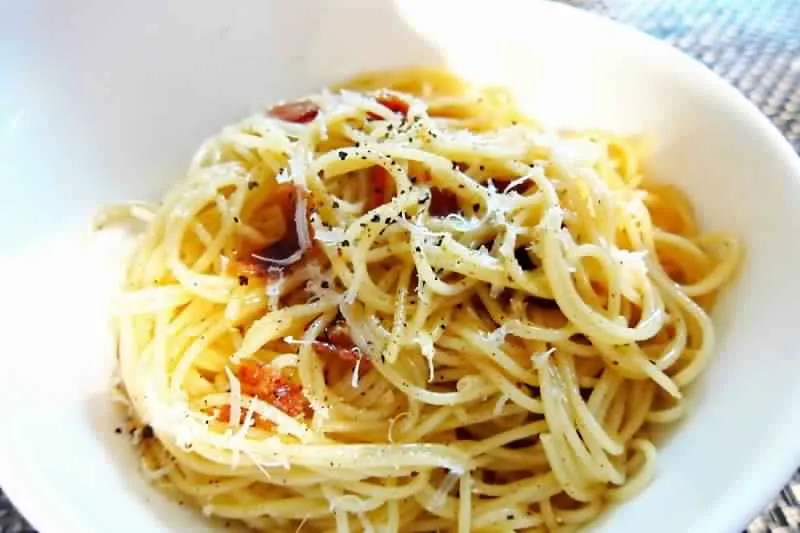Pasta carbonara is a common recipe from Rome and the surrounding areas, and it dates back to not too many years ago though its origins are still unclear today. It is known as a recipe that is replicated everywhere and often with variations. Let me try to reconstruct the history of the pasta carbonara and its origins, and then I’ll move to the authentic Italian pasta carbonara recipe.
DO YOU KNOW THAT THE ORIGIN OF SPAGHETTI CARBONARA IS, IN FACT, UNCLEAR?
Let’s start with the basics: Ada Boni, one of the top experts in Roman cooking, does not talk about carbonara in his famous book dated 1930, leaving open several paths to understanding what this dish really is.
According to some, the spaghetti carbonara came to Rome and Lazio after the liberation of Rome in 1944 when Americans introduced bacon and lyophilized eggs to Italy; an explanation that is not very convincing since the primary element of this recipe is the pork cheek and not the bacon. But, however, if we want to analyze the question in depth, we must consider that the American origin of this dish would also explain the presence of cream and butter in some versions of carbonara. The soldiers, according to some reconstructions, brought condensed milk with them to make their spaghetti more creamy.
Another theory attributes the dish to the Neapolitan area, considering also the presence of a quite similar dish in the book Cucina teorico-pratica by Ippolito Cavalcanti, and the presence in the Neapolitan kitchen of dishes that are seasoned using the same identical ingredients.
Another very acclaimed theory claims instead that carbonara is derived directly from the cacio and ova from Lazio and Abruzzo regions, and that it was born thanks to the lumberjackers who carried their eggs, their pecorino cheese and pork cheek in bags to make the pasta during their migrations. The pepper was not added posthumously but was used to keep the “guanciale”(pork cheek) and then ended up in the cooking pan, resulting in dark color. In support of this thesis also, the word “carbonara” closely resembles “carbonada”, the term to name the guanciale in Abruzzo.
THE ORIGIN OF THE CARBONARA IS, THEREFORE, QUITE UNKNOWN AND IT IS FOR THIS REASON THAT ITS FAME PROBABLY HAS ALSO GROWN OVER TIME.
The most used pasta sizes for the carbonara pasta are the rigatoni, but most of all the spaghetti that hold up during cooking and blend well with the ingredients. Although many people make the carbonara pasta with cream, the recipe does not include either this ingredient nor onion, garlic or parsley, and of course no chicken and meat apart from the guanciale. An excellent recipe for carbonara pasta is found in the book La cucina romana e del Lazio by Livio Jannattoni, where the author confirms that for pasta carbonara, it is not necessary the use of guanciale but you can also use bacon.
Do you know that for pasta amatriciana you should only use guanciale and never bacon? For the carbonara you can use both, being careful to brown the bacon in a little oil if you choose to use this ingredient instead of the pork cheek that does not require oil at all. The final result is a nice pasta carbonara, soft, tasty and appetizing!
HOW TO MAKE A REAL PASTA CARBONARA PREPARED ACCORDING TO THE AUTHENTIC ITALIAN AND ROMAN RECIPE
PASTA CARBONARA: INGREDIENTS FOR TWO PEOPLE
1 egg for each person
200 grams of pasta
100 grams of guanciale or bacon
50 grams of Roman pecorino cheese (of course grated sheep milk cheese) *If you cannot find it you can use Parmesan but the taste it is not the same!
salt
pepper
PASTA CARBONARA: DIRECTIONS
Take the guanciale (pork cheek) and cut it into squares, then brown it in a frying pan and turn it off when it is hardened and well roasted outside.
While the pasta boils in salt water, season the eggs with salt (not much because the pillow is already tasty), a handful of pecorino cheese and a bit of black pepper mixing well. Drain the pasta al dente, pour it into the frying pan where the pillow was browned and make it absorb the seasoning by mixing it with a wooden spoon.
Pour the dough into the cooking pot, add the beaten eggs and mix so that the egg does not become a kind of omelette (this operation must be done out of the stove). Add another pinch of pepper and possibly more pecorino cheese and serve.
Preparation time: 16 minutes
DO YOU WANT TO MAKE CREAMY CARBONARA?
Then mix the eggs with the guanciale then pour the pasta into the cooking pan of the guanciale, add the mixture of eggs and pork cheek and stir out of the stove; in this way you will get a creamy carbonara without having to add any ingredients that it’s not in the authentic recipe, cream for first.